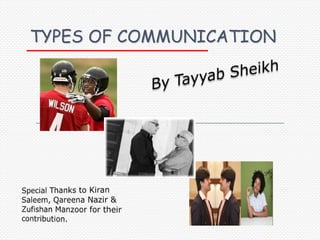
Types of communication
- 2. What is communication ? The word communication has originated from a Latin word “Communes” which means something common. Communication is a process of exchanging information, ideas, thoughts, feeling and emotions through speech signals, writing or behavior. In communication process, a sender encodes a message and then using a medium and send it to appropriate feedback using a medium
- 3. Importance of communication Express thoughts, ideas and feelings Creating awareness To fulfill a goal Avoid isolated Highlight issues Progress, development Educating the masses etc.
- 4. Means of communication communication verbal Non-verbal
- 5. Verbal Communication Verbal communication is refers to the form of communication in which message is transmitted verbally, communication is done by word, mouth and a piece of writing. Objective of every communication is to have people understood what we are trying to convey.
- 6. Parts of verbal communication Verbal Oral written
- 7. Oral Communication In oral communication, Spoken words are used. It includes face-to-face conversations, speech, telephonic conversation, video, radio, television, v oice over internet. In oral communication, communication is influence by pitch, volume, speed and clarity of speaking
- 8. written Communication In written communication, written signs or symbols are used to communicate. A written message may be printed or hand written. In written communication message can be transmitted via email, letter, report, memo etc. Message, in written communication, is influenced by the vocabulary & grammar used, writing style, precision and clarity of the language used.
- 9. Non-verbal communication Through signs & symbols. Non-verbal can go without verbal communication. Verbal can’t go without non-verbal communication.
- 10. Importance of Non-verbal communication The way message is conveyed words 10% Body language 1st Qtr 2nd Qtr 50% 3rd Qtr Tone of voice 40%
- 11. Types of Non-verbal communication • KINESICS (BODY LANGUAGE) HAPTICS (TOUCH LANGUAGE) PROXEMICS ,(SPACE LANGUAGE) ARTIFACTS ENVIRONMENTAL CHRONEMICS (TIME LANGUAGE) SILENCE SIGN PARALANGUAGEVOCALIC
- 12. Types of Non-verbal communication KINESICS (BODY LANGUAGE) FACIAL EXPRESSION HEAD EYE GAZE GESTURES POSTURES SHAPE OF BODY PERSONAL APPEARANCE ADORNMENT
- 13. FACIAL EXPRESSION Face is the index of mind. Think how much information can be conveyed with a smile or a frown. By facial expressions we can show or we can understand happiness, sadness, anger and fear and much more
- 14. HEAD If someone move hisher head up & down it means heshe is agree with you or saying yes and it also means understanding and acknowledgement. Sideways movement of head means no or not understood. If a person bring his head down and looking his feet or earth it is the symbol of humility & modesty.
- 15. EYE GAZE Looking at another person can indicate a range of emotions like anger, grudge and danger, a dangerous look can tell you someone is unhappy and not comfortable with
- 17. SHAPE OF BODY
- 18. PERSONAL APPEARANCE ADORNMENT Appearance can indicate our profession It shows your nature, interest and your taste It can also point out our religious and cultural values
- 20. Proxemics (Space language) To communicate while keeping a distance is called proxemics The amount of distance we need and the amount of space we perceive as belonging to us is influenced by a number of factors including social norms, situational factors, personality characteristics and level of familiarity
- 21. Signs
- 22. ARTIFACTS ENVIRONMENTAL FACTORS APPROPRIATENESS CLIMATE MICROENVIRONMENTS SCENT (OLFACTICS) COLOR LIGHTING
- 23. CHRONEMICS (TIME LANGUAGE) A call at 2 a.m. indicates some kind of emergency You reached in a party on time shows you are punctual
- 24. Silence Allowing silence in a conversation puts pressure on the other person. Silence can indicate hostility. Silence can indicate disagreement. Silence can indicate profoundness, such as horror. Silence can indicate respect. Silence can indicate contemplation. Silence can be intentional rudeness. Silence can be the creation of a listening space. Silence can be an indication of empathy.
- 25. Paralanguage/Vocalics Attributes of speaking which include the pitch, the tone, the volume, tempo, rhythm, articulation, resonance, nasality and even the accent of the speaker collectively known as paralanguage, we can understand mood and the situation by paralanguage expressions
- 26. TYPES OF COMMUNICATION Inter-personal communication Communication between two or more people called inter-personal communication
- 27. Intra-personal communication Intra-personal communication is a process in which people communicate with themselves either consciously or unconsciously
- 28. Extra-personal communication Communication between human beings and nonhuman entities
- 30. Mass communication Communication through electronic gadgets (mass media) like books, journals, TV, newspapers etc
- 31. Effective Communication GATHER YOUR THOUGHTS CHOOSE YOUR WORDS VOICE MODULATION BODY LANGUAGE LISTEN CONCENTRATE EYE CONTACT POSTURES SIMPLE OR FAMILIAR LANGUAGE QUESTIONING SKILLS
